We’re finally putting a stopper in the storm drains, as we wind down this current trial with an overview of more recent feature and theatrical animation, which has become much of the haven for more recent special effects spectacle in weather extremes. Many studios worldwide are represented, and, though again unlikely to represent a comprehensive list of weather events on the big screen, it is hoped this survey will cover most of the high spots where weather played an important role in plot development.
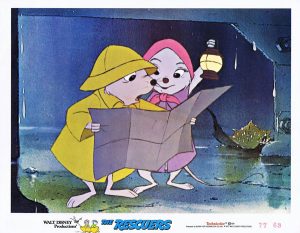 Both Disney’s The Rescuers (6/22/77) and The Rescuers Down Under (11/16/90), include brief weather sequences as comic elements for the operations of Albatross Airlines, a flight service operating from a corner of the roof of a New York heliport, catering to a clientele of mice, who ride atop live albatross birds while seated in a sardine can strapped to the bird’s back. In the original feature, a final takeoff is accomplished backwards, as the elder brother of the birds, Orville, is blown in reverse off the rooftop by the force of a winter blizzard. Orville and his passengers are only saved by the intervention of Evinrood, an outboard-motor dragonfly who has been instrumental in the earlier storyline, who gives a boost to Orville’s tail to level him off from an uncontrolled dive. In the sequel film, brother Wilbur remains holed up in his hangar as another blizzard rages across the airstrip, until mouse agent Bianca warms and ignites his fighting spirit with her tale of the plight of the boy in Australia they desire to rescue. The sequence is brief, but determined Wilbur endures ice-filled headwinds, which he attempts to duck under, ice slicks on the runway, and charges through snowdrifts to reach the dropoff point of the runway, then, in his brother’s best tradition, cannonball-dives off the roof for about 50 stories, pulling up just shy of Times Square traffic, and causing a collision below between three vehicles. As Bernard observes in both films, “Sure wish we’d’ve taken the train.”
Both Disney’s The Rescuers (6/22/77) and The Rescuers Down Under (11/16/90), include brief weather sequences as comic elements for the operations of Albatross Airlines, a flight service operating from a corner of the roof of a New York heliport, catering to a clientele of mice, who ride atop live albatross birds while seated in a sardine can strapped to the bird’s back. In the original feature, a final takeoff is accomplished backwards, as the elder brother of the birds, Orville, is blown in reverse off the rooftop by the force of a winter blizzard. Orville and his passengers are only saved by the intervention of Evinrood, an outboard-motor dragonfly who has been instrumental in the earlier storyline, who gives a boost to Orville’s tail to level him off from an uncontrolled dive. In the sequel film, brother Wilbur remains holed up in his hangar as another blizzard rages across the airstrip, until mouse agent Bianca warms and ignites his fighting spirit with her tale of the plight of the boy in Australia they desire to rescue. The sequence is brief, but determined Wilbur endures ice-filled headwinds, which he attempts to duck under, ice slicks on the runway, and charges through snowdrifts to reach the dropoff point of the runway, then, in his brother’s best tradition, cannonball-dives off the roof for about 50 stories, pulling up just shy of Times Square traffic, and causing a collision below between three vehicles. As Bernard observes in both films, “Sure wish we’d’ve taken the train.”
 The Great Mouse Detective (Disney, 7/2/86) uses rain to heighten dramatic effect in an action-filled finale. Professor Ratigan’s scheme to replace the mouse queen of England with a robot double on her Golden Jubilee has just been foiled by Basil of Baker Street (a mouse counterpart to the great Sherlock Holmes, operating from the basement of Holmes’s apartment). To make good his escape, Ratigan has kidnapped and made off with the daughter of the robot’s inventor, using her as hostage. He pilots a miniature airship powered by a prop driven by bictcle pedaling. Basil, Dr. Dawson, and the girl’s father follow in a wild air race, via Basil’s inventive idea of stringing together several full-size rubber ballons under the draping of a British flag with its corners tied to the rim of a wicker picnic basket. Basil leaps into Ratigan’s airship, distracting the villain long enough to cause him to crash the airship into the face of Big Ben, knocking a hole through the clock’s stained glass. Lightning and rain fill the sky as Ratigan, Basil, and the girl disappear inside the clock tower. A perilous pursuit ensues within, amidst the ever-moving gears, chains, and springs of the massive clockwork mechanism, moving outside to a small ledge overlooking one of the clock’s faces at the top of the tower. Basil attempts to hand off the little girl to her father, hovering as close to the tower as he can manage in the balloon. The fingers of the girl and father are only fractions of an inch apart from reach. Basil is jumped from behind by Ratigan, pushing Basil off the ledge. The hero and villain fall together, but the girl is flipped upwards into the air, just enough to reach her father’s grasp. Basil lands upon one of the hands of the giant clock, made slippery and precarious by the continuing rain. Atop the other hand rises Ratigan, determined to finish the battle once and for all, and abandoning all pretense of dignity to bare his sharp rat’s claws, fiercely slashing with all his might at Basil. As lightning flashes for effect, the battle rages, until a scarred and battered Basil hangs on for his life to the edge of one of the hands. Ratigan delivers a final blow, causing Basul to drop from the clock hand into free fall. When a moment passes in silence, with Basil not returning, Ratigan’s face breaks into a broad, evil grin, as he shouts to the world, “I’ve won!” “On the contrary”, calls a voice from below. Ratigan peers over the side, to view the rear end of his airship still protruding through the hole made in the clock face, with Basil clinging to the tail prop mechanism. “The game isn’t over yet”, calls out Basil, as a loud click of the clock mechanism sets the minute hand of the clock pointing directly at twelve. A tremendous “BONG” rattles the building, jostling Ratigan’s footing from the slippery clock hand on which he stands. Ratigan tumbles and falls, but manages to lay a final hand upon Basil on the way down, pulling Basil and the airship’s tail mechanism along with him. All of them descend through a blanket of fog around the clock’s base, and there is silence. Dawson, the father and daughter look down from the balloon, and the daughter begins to weep at Basil’s fate. But the spinning of gears is softly heard from the fogbank below. Up from the mist rises a spinning propeller, repositioned vertically to act as a helicopter – powered by Basil, pedaling with all his might upon the bicycle pedals of the airship’s prop mechanism. Basil is saved, and all ends happily.
The Great Mouse Detective (Disney, 7/2/86) uses rain to heighten dramatic effect in an action-filled finale. Professor Ratigan’s scheme to replace the mouse queen of England with a robot double on her Golden Jubilee has just been foiled by Basil of Baker Street (a mouse counterpart to the great Sherlock Holmes, operating from the basement of Holmes’s apartment). To make good his escape, Ratigan has kidnapped and made off with the daughter of the robot’s inventor, using her as hostage. He pilots a miniature airship powered by a prop driven by bictcle pedaling. Basil, Dr. Dawson, and the girl’s father follow in a wild air race, via Basil’s inventive idea of stringing together several full-size rubber ballons under the draping of a British flag with its corners tied to the rim of a wicker picnic basket. Basil leaps into Ratigan’s airship, distracting the villain long enough to cause him to crash the airship into the face of Big Ben, knocking a hole through the clock’s stained glass. Lightning and rain fill the sky as Ratigan, Basil, and the girl disappear inside the clock tower. A perilous pursuit ensues within, amidst the ever-moving gears, chains, and springs of the massive clockwork mechanism, moving outside to a small ledge overlooking one of the clock’s faces at the top of the tower. Basil attempts to hand off the little girl to her father, hovering as close to the tower as he can manage in the balloon. The fingers of the girl and father are only fractions of an inch apart from reach. Basil is jumped from behind by Ratigan, pushing Basil off the ledge. The hero and villain fall together, but the girl is flipped upwards into the air, just enough to reach her father’s grasp. Basil lands upon one of the hands of the giant clock, made slippery and precarious by the continuing rain. Atop the other hand rises Ratigan, determined to finish the battle once and for all, and abandoning all pretense of dignity to bare his sharp rat’s claws, fiercely slashing with all his might at Basil. As lightning flashes for effect, the battle rages, until a scarred and battered Basil hangs on for his life to the edge of one of the hands. Ratigan delivers a final blow, causing Basul to drop from the clock hand into free fall. When a moment passes in silence, with Basil not returning, Ratigan’s face breaks into a broad, evil grin, as he shouts to the world, “I’ve won!” “On the contrary”, calls a voice from below. Ratigan peers over the side, to view the rear end of his airship still protruding through the hole made in the clock face, with Basil clinging to the tail prop mechanism. “The game isn’t over yet”, calls out Basil, as a loud click of the clock mechanism sets the minute hand of the clock pointing directly at twelve. A tremendous “BONG” rattles the building, jostling Ratigan’s footing from the slippery clock hand on which he stands. Ratigan tumbles and falls, but manages to lay a final hand upon Basil on the way down, pulling Basil and the airship’s tail mechanism along with him. All of them descend through a blanket of fog around the clock’s base, and there is silence. Dawson, the father and daughter look down from the balloon, and the daughter begins to weep at Basil’s fate. But the spinning of gears is softly heard from the fogbank below. Up from the mist rises a spinning propeller, repositioned vertically to act as a helicopter – powered by Basil, pedaling with all his might upon the bicycle pedals of the airship’s prop mechanism. Basil is saved, and all ends happily.
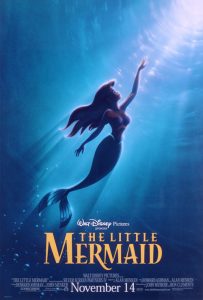 The Little Mermaid (Disney. 11/17/89) includes two sequences of dramatic storm action between its primary doings under the sea. A fireworks display above the water’s surface attracts Ariel’s attention. It is the birthday celebration for Prince Eric, aboard a royal ship. Ariel climbs the side of the ship and hides along the outside railings, getting her first close-up view of humans, and experiencing love at first sight as she views the prince cavorting with his sheepdog Max. Max nearly gives her away when he picks up her scent, but instead playfully slurps her on the face. The festivities are abruptly interrupted when a lookout calls out that a hurricane is bearing down upon them. The waves rise, washing fiercely across the deck. Several seamen are washed overboard, and Eric himself takes the helm. Ariel jumps back into the water, and observes as rigging of the ship begins to snap, and masts and sails tatter and fall. A lightning strike sets the remaining sails afire, as Eric and the crew take to the lifeboat. But Max still remains aboard. Eric grabs a trailing rope from the ship, climbing hand over hand to return to the deck. He coaxes Max to jump into his arms from the poopdeck, then tosses the dog to safety over the side. But the fire and falling rigging trap Eric from making an escape himself, then the flames hit the powder room. The ship is blown apart, and as Ariel scans the water for any sign of the prince, she observes him, weakly clinging to a small floating piece of spar, then slipping into unconsciousness, and submerging beneath the waves. Ariel dives, rescuing the prince from his descent to the bottom. By the next morning, Ariel has left Eric safe upon the sands of a nearby shore, departing just as he begins to regain consciousness, and leaving him with only a brief memory of a glimpse of her face and her lovely singing voice.
The Little Mermaid (Disney. 11/17/89) includes two sequences of dramatic storm action between its primary doings under the sea. A fireworks display above the water’s surface attracts Ariel’s attention. It is the birthday celebration for Prince Eric, aboard a royal ship. Ariel climbs the side of the ship and hides along the outside railings, getting her first close-up view of humans, and experiencing love at first sight as she views the prince cavorting with his sheepdog Max. Max nearly gives her away when he picks up her scent, but instead playfully slurps her on the face. The festivities are abruptly interrupted when a lookout calls out that a hurricane is bearing down upon them. The waves rise, washing fiercely across the deck. Several seamen are washed overboard, and Eric himself takes the helm. Ariel jumps back into the water, and observes as rigging of the ship begins to snap, and masts and sails tatter and fall. A lightning strike sets the remaining sails afire, as Eric and the crew take to the lifeboat. But Max still remains aboard. Eric grabs a trailing rope from the ship, climbing hand over hand to return to the deck. He coaxes Max to jump into his arms from the poopdeck, then tosses the dog to safety over the side. But the fire and falling rigging trap Eric from making an escape himself, then the flames hit the powder room. The ship is blown apart, and as Ariel scans the water for any sign of the prince, she observes him, weakly clinging to a small floating piece of spar, then slipping into unconsciousness, and submerging beneath the waves. Ariel dives, rescuing the prince from his descent to the bottom. By the next morning, Ariel has left Eric safe upon the sands of a nearby shore, departing just as he begins to regain consciousness, and leaving him with only a brief memory of a glimpse of her face and her lovely singing voice.
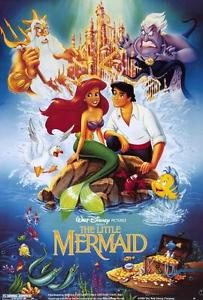 The finale of the film finds Eric and Ariel at the mercies of Ursula the sea witch, a half-woman, half-octopus, who has driven a hard bargain with King Triton to obtain his all-powerful trident in return for Ariel’s freedom. The King, under Ursula’s magical power, is reduced to a shriveled slug-like form, while Ursula wields the trident to blast away at those who would oppose her. Ariel and Eric attempt to intervene, but are no match for her new power, and make a tactical retreat to the surface. Ursula, whether by her own magic or the amplification of it through the trident, begins to spread a blanket of black octopus ink through the water, then starts to grow exponentially. Her ink-soaked head towers out of the water, appearing nearly underneath Ariel and Eric, who find themselves encompassed in her looing shadow. The Disney animators remembered their roots, and, while making no direct reuse of the original antiquated animation, roughly choreograph the confrontation in manner very similar to the climactic scenes of 1932’s “King Neptune”. Ursula points the trident tip into the water, and begins to stir the surface, producing a huge whirlpool. She boasts at her new ability to make the sea obey her every whim, and casts massive waves down upon Ariel and Eric. Ariel is sucked into the whirlpool’s center descending to the bottom, where the opening waters reveal her attempting to hide within the rocky surfaces below. Eric, however, rides the current of the swirling waters, meeting up with the hull of a sunken ship which is also swept into the current from the bottom. Eric repeats his feat of grabbing a trailing hawser line from the ship, and climbing hand over hand to the deck. He again takes the helm, turning the ship’s wheel to alter its course. While Ursula remains engaged in a game of cat-and-mouse, blasting away at Ariel with bolts of energy from the trident. Eric steers the ship around the whirlpool’s edge, lining up in a collision path to intersect Ursula’s back with the jagged, broken bowsprit of the wrecked ship. The tactic works, and Ursula receives a fatal stab wound in the back. She screams, then begins to shrink and deflate, her writhing form disappearing back into the water. Eric and Ariel are reunited, as Ursula loses grip upon the trident. As Ursula’s life ebbs, so do the results of her spells, and all those she has turned into sea slugs revert to merpeople again, including King Triton, who takes up the fallen trident, regaining his rightful royal powers.
The finale of the film finds Eric and Ariel at the mercies of Ursula the sea witch, a half-woman, half-octopus, who has driven a hard bargain with King Triton to obtain his all-powerful trident in return for Ariel’s freedom. The King, under Ursula’s magical power, is reduced to a shriveled slug-like form, while Ursula wields the trident to blast away at those who would oppose her. Ariel and Eric attempt to intervene, but are no match for her new power, and make a tactical retreat to the surface. Ursula, whether by her own magic or the amplification of it through the trident, begins to spread a blanket of black octopus ink through the water, then starts to grow exponentially. Her ink-soaked head towers out of the water, appearing nearly underneath Ariel and Eric, who find themselves encompassed in her looing shadow. The Disney animators remembered their roots, and, while making no direct reuse of the original antiquated animation, roughly choreograph the confrontation in manner very similar to the climactic scenes of 1932’s “King Neptune”. Ursula points the trident tip into the water, and begins to stir the surface, producing a huge whirlpool. She boasts at her new ability to make the sea obey her every whim, and casts massive waves down upon Ariel and Eric. Ariel is sucked into the whirlpool’s center descending to the bottom, where the opening waters reveal her attempting to hide within the rocky surfaces below. Eric, however, rides the current of the swirling waters, meeting up with the hull of a sunken ship which is also swept into the current from the bottom. Eric repeats his feat of grabbing a trailing hawser line from the ship, and climbing hand over hand to the deck. He again takes the helm, turning the ship’s wheel to alter its course. While Ursula remains engaged in a game of cat-and-mouse, blasting away at Ariel with bolts of energy from the trident. Eric steers the ship around the whirlpool’s edge, lining up in a collision path to intersect Ursula’s back with the jagged, broken bowsprit of the wrecked ship. The tactic works, and Ursula receives a fatal stab wound in the back. She screams, then begins to shrink and deflate, her writhing form disappearing back into the water. Eric and Ariel are reunited, as Ursula loses grip upon the trident. As Ursula’s life ebbs, so do the results of her spells, and all those she has turned into sea slugs revert to merpeople again, including King Triton, who takes up the fallen trident, regaining his rightful royal powers.
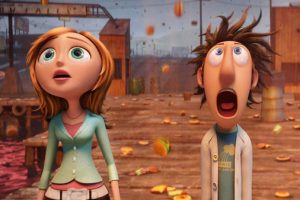 Cloudy With a Chance of Meatballs (Sony Animation, 9/18/09) – An energetic, imaginative adaptation of a children’s book, about weather phenomena never before forecast by any meteorologist. Eccentric young inventor Flint Lockwood (whose first invention as a child was to encase his feet in spray-on shoes – which never come off) resides in a small down-and-out former fishing community on an East Coast island. Flint has hit upon an idea to revolutionize world hunger – a device which can replicate any kind of food, out of water. He experiments with his prototype in a backyard lab constructed inside a water tower, assisted by his lab monkey Steve (who communicates with him through a thought translator box), but the prototype continually shorts out the power, requiring too much electricity. Flint figures a way to store sufficient energy for the device’s lifetime, but needs to tap into the city’s main power generators ro obtain the voltage. His patch wires stoke the energy cells to the max, causing his machine to jet all over town like a rocket-driven ball in a pinball machine, then drop Flint over the side, as it launches itself into the heavens and out of sight. Flint’s machine has wrecked the planned attractions for what was to be his home-town’s last hope for economic turnaround (a sardine-themed amusement park), but most of all has broken the hopes of Flint’s dad, who is unable to understand Flint’s inventive spirit, and only hopes to keep Flint out of trouble and as a junior partner in his bait-and-tackle shop.
Cloudy With a Chance of Meatballs (Sony Animation, 9/18/09) – An energetic, imaginative adaptation of a children’s book, about weather phenomena never before forecast by any meteorologist. Eccentric young inventor Flint Lockwood (whose first invention as a child was to encase his feet in spray-on shoes – which never come off) resides in a small down-and-out former fishing community on an East Coast island. Flint has hit upon an idea to revolutionize world hunger – a device which can replicate any kind of food, out of water. He experiments with his prototype in a backyard lab constructed inside a water tower, assisted by his lab monkey Steve (who communicates with him through a thought translator box), but the prototype continually shorts out the power, requiring too much electricity. Flint figures a way to store sufficient energy for the device’s lifetime, but needs to tap into the city’s main power generators ro obtain the voltage. His patch wires stoke the energy cells to the max, causing his machine to jet all over town like a rocket-driven ball in a pinball machine, then drop Flint over the side, as it launches itself into the heavens and out of sight. Flint’s machine has wrecked the planned attractions for what was to be his home-town’s last hope for economic turnaround (a sardine-themed amusement park), but most of all has broken the hopes of Flint’s dad, who is unable to understand Flint’s inventive spirit, and only hopes to keep Flint out of trouble and as a junior partner in his bait-and-tackle shop.
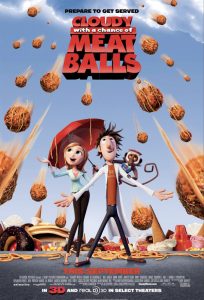 As Flint hides from the angered populace of the town, he meets an apprentice female newscaster (Samantha “Sam” Sparks) whose debut broadcast covering the sardine-land unveiling was ruined by Flint’s device. Despite her initial anger toward Flint, the two find a commonality between them. Secretly, she is a frustrated science nerd too, with a passion for weather science and technology. She commiserates with Flint’s frustrations, but then joins him in unexpected celebration, when the components of cheeseburgers begin an increasing downpour from a gathering storm front of never-before-seen pink clouds. Flint recalls his machine was programmed for cheeseburgers when it launched into the sky, and Sam adds to the deduction that the water vapor in the clouds must be supplying the fuel for the food conversion. The storm increases in intensity, and completed cheeseburgers fall from the heavens all over town. Sam cues her cameraman, and is back on the air breaking the story of the century. And Flint is for the first time proclaimed a hero, despite his destructive antics – the mayor seeing this wonderous marvel as the new ticket to attract tourism to the town. But just cheeseburgers? Not if Flint can help it. Constructing a communications satellite dish system to interface with his machine in the sky, Flint finds the ability to reprogram the device’s menu to order, providing a new bill of fare three times a day. Requests pour in from the townspeople for their favorite dishes and snacks to be next on Flint’s programing list, and Flint does his best to keep up. Covering the roofs of the town with giant scoops of ice cream and the ground with a coating of the icy stuff, to provide the local police chief’s son with an ice-cream snow day on his birthday. Supplying Sam with an entire castle made of her favorite foodstuff – lemon Jello. Even providing dinner in a new wy for a gourmet restaurant franchise – the Roofless Restaurant, where steaks drop from the sky to land on your platter. But the variety of requests are beginning to tax the abilities of the machine, as readings on the molecular mutation gauge begin to climb into the yellow caution zone. The mayor, bloating himself like a fat pig from all the free-falling goodies, becomes more and more obsessed and demanding of Flint as the date for a grand opening of the island to tourist cruises draws near. To make things more impressive, he tampers with the commands from Flint’s computer to the machine, requesting that the morning’s meal be a Vegas-style all you can eat buffet. This is the straw that breaks the camel’s back. Foods grow to humongous sizes, as king-size steaks begin to smash the platters and tables at the roofless restaurant. The town is hit by a spaghetti twister. Warning meters go into the red, as giant hot dogs, pizzas, pancakes with syrup and butter, and nearly every other food imaginable rain upon the town, covering or collapsing buildings, making splashdowns upon ships in the harbor, and overfilling a portion of the island which Flint has set aside as a depository for the uneaten leftovers from every meal, bursting a retaining wall and setting loose a flood of giant food upon the town. Most of the populace escapes the flood by fashioning items of the giant food into makeshift marine craft, and taking to sea to avoid the food-flood. Flint, Sam, Steve the monkey, and a few other select townsfriends take to the skies in a flying car invented by Flint, armed with a thumb drive containing a kill code to shut the machine down permanently.
As Flint hides from the angered populace of the town, he meets an apprentice female newscaster (Samantha “Sam” Sparks) whose debut broadcast covering the sardine-land unveiling was ruined by Flint’s device. Despite her initial anger toward Flint, the two find a commonality between them. Secretly, she is a frustrated science nerd too, with a passion for weather science and technology. She commiserates with Flint’s frustrations, but then joins him in unexpected celebration, when the components of cheeseburgers begin an increasing downpour from a gathering storm front of never-before-seen pink clouds. Flint recalls his machine was programmed for cheeseburgers when it launched into the sky, and Sam adds to the deduction that the water vapor in the clouds must be supplying the fuel for the food conversion. The storm increases in intensity, and completed cheeseburgers fall from the heavens all over town. Sam cues her cameraman, and is back on the air breaking the story of the century. And Flint is for the first time proclaimed a hero, despite his destructive antics – the mayor seeing this wonderous marvel as the new ticket to attract tourism to the town. But just cheeseburgers? Not if Flint can help it. Constructing a communications satellite dish system to interface with his machine in the sky, Flint finds the ability to reprogram the device’s menu to order, providing a new bill of fare three times a day. Requests pour in from the townspeople for their favorite dishes and snacks to be next on Flint’s programing list, and Flint does his best to keep up. Covering the roofs of the town with giant scoops of ice cream and the ground with a coating of the icy stuff, to provide the local police chief’s son with an ice-cream snow day on his birthday. Supplying Sam with an entire castle made of her favorite foodstuff – lemon Jello. Even providing dinner in a new wy for a gourmet restaurant franchise – the Roofless Restaurant, where steaks drop from the sky to land on your platter. But the variety of requests are beginning to tax the abilities of the machine, as readings on the molecular mutation gauge begin to climb into the yellow caution zone. The mayor, bloating himself like a fat pig from all the free-falling goodies, becomes more and more obsessed and demanding of Flint as the date for a grand opening of the island to tourist cruises draws near. To make things more impressive, he tampers with the commands from Flint’s computer to the machine, requesting that the morning’s meal be a Vegas-style all you can eat buffet. This is the straw that breaks the camel’s back. Foods grow to humongous sizes, as king-size steaks begin to smash the platters and tables at the roofless restaurant. The town is hit by a spaghetti twister. Warning meters go into the red, as giant hot dogs, pizzas, pancakes with syrup and butter, and nearly every other food imaginable rain upon the town, covering or collapsing buildings, making splashdowns upon ships in the harbor, and overfilling a portion of the island which Flint has set aside as a depository for the uneaten leftovers from every meal, bursting a retaining wall and setting loose a flood of giant food upon the town. Most of the populace escapes the flood by fashioning items of the giant food into makeshift marine craft, and taking to sea to avoid the food-flood. Flint, Sam, Steve the monkey, and a few other select townsfriends take to the skies in a flying car invented by Flint, armed with a thumb drive containing a kill code to shut the machine down permanently.
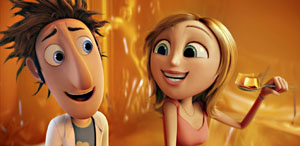
“Flint Lockwood” voiced by Bill Hader and “Sam Sparks” voiced by Anna Faris.
 My Neighbor Totoro (Hayao Miyazaki, 4/16/88) includes a charming signature sequence involving a little girl waiting at night at a bus stop in the rain, at a remote roadside location near the forest. She has brought along a spare umbrella in addition to her own, intending to give it to her Dad. To her amazement and surprise, she suddenly finds herself sharing the space at the bus stop with the towering Totoro, a furry, rotund forest spirit about six times her size. Totoro is casual and matter-of-fact about this chance meeting, paying little attention to the girl’s presence, and calmly waiting in place for his own ride to arrive. The little girl observes that Totoro has brought along no protection from the rain excepting a single leaf worn atop his head, and raindrops dripping from the branches of a tree above continually make direct hits upon Totoro’s nose. Totoro endures this unemotionally, until the little girl decides to help. Timidly, she offers Totoro the spare umbrella. Totoro at first has no notion of what the device is for, and twirls it at various angles in his paws, studying it. “Hold it above your head”, says the girl, illustrating with her own umbrella.
My Neighbor Totoro (Hayao Miyazaki, 4/16/88) includes a charming signature sequence involving a little girl waiting at night at a bus stop in the rain, at a remote roadside location near the forest. She has brought along a spare umbrella in addition to her own, intending to give it to her Dad. To her amazement and surprise, she suddenly finds herself sharing the space at the bus stop with the towering Totoro, a furry, rotund forest spirit about six times her size. Totoro is casual and matter-of-fact about this chance meeting, paying little attention to the girl’s presence, and calmly waiting in place for his own ride to arrive. The little girl observes that Totoro has brought along no protection from the rain excepting a single leaf worn atop his head, and raindrops dripping from the branches of a tree above continually make direct hits upon Totoro’s nose. Totoro endures this unemotionally, until the little girl decides to help. Timidly, she offers Totoro the spare umbrella. Totoro at first has no notion of what the device is for, and twirls it at various angles in his paws, studying it. “Hold it above your head”, says the girl, illustrating with her own umbrella.
 Totoro gradually gets the idea, and does so. He does not immediately react to the device’s effect, until another drop of water falls from the tree above, hitting the fabric instead of his nose. Totoro’s eyes widen in surprise. Then, another drop from above hits the fabric instead of him, followed by a small flurry of drops blown from the tree by the wind, which all patter upon the fabric above him. Totoro’s eyes widen more, and a broad grin spreads across his face. To get the full effect of this miraculous invention, Totoro leaps several feet off the ground, landing back on the sidewalk with a resounding thud from the force of his sheer body weight. The vibrations from his impact cause the little girl to briefly scream, as she and the bus stop sign are bounced momentarily upwards and off the pavement. The vibration also shakes the branches of the large tree overhanging above them, so that the built-up rain accumulated upon its leaves and branches falls down all at once, deluging both umbrellas in a few seconds of torrential downpour. Totoro’s head remains high and dry, and Totoro lets out a mighty roar of delight. Then Totoro’s ride shows up – a living, breathing giant creature with about eight legs, shaped like an orange cat but hollow above its backbone to take on the shape of a passenger bus. Its eyes glow as if headlights, and a doorway opening in its back expands to allow Totoro to step aboard. Before boarding, Totoro pays for the umbrella with a small bag of magic tree seeds, then rides away, as the cat-bus leaps its way down the road and over the countryside. The little girl can only comment, “Well, so much for bringing Dad his umbrella.”
Totoro gradually gets the idea, and does so. He does not immediately react to the device’s effect, until another drop of water falls from the tree above, hitting the fabric instead of his nose. Totoro’s eyes widen in surprise. Then, another drop from above hits the fabric instead of him, followed by a small flurry of drops blown from the tree by the wind, which all patter upon the fabric above him. Totoro’s eyes widen more, and a broad grin spreads across his face. To get the full effect of this miraculous invention, Totoro leaps several feet off the ground, landing back on the sidewalk with a resounding thud from the force of his sheer body weight. The vibrations from his impact cause the little girl to briefly scream, as she and the bus stop sign are bounced momentarily upwards and off the pavement. The vibration also shakes the branches of the large tree overhanging above them, so that the built-up rain accumulated upon its leaves and branches falls down all at once, deluging both umbrellas in a few seconds of torrential downpour. Totoro’s head remains high and dry, and Totoro lets out a mighty roar of delight. Then Totoro’s ride shows up – a living, breathing giant creature with about eight legs, shaped like an orange cat but hollow above its backbone to take on the shape of a passenger bus. Its eyes glow as if headlights, and a doorway opening in its back expands to allow Totoro to step aboard. Before boarding, Totoro pays for the umbrella with a small bag of magic tree seeds, then rides away, as the cat-bus leaps its way down the road and over the countryside. The little girl can only comment, “Well, so much for bringing Dad his umbrella.”
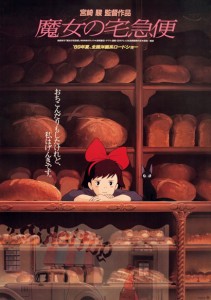 Kiki’s Delivery Service (Hayao Miyazaki, 7/29/89) features in its climactic scenes an outbreak of extreme winds that breaks a dirigible loose from its moorings. Half the town attempts to hold onto the nose ropes of the airship to tether it down, and the end of the rope is tied to the bumper of a police car for extra weight. But the winds increase again, shaking loose all but a single boy from the rope, and raising the ship into the air, lifting the police car with it. Kiki, a young girl in training as an apprentice witch, who is experiencing a crisis in her self-confidence and a resulting diminishment of her powers, attempts to make a rescue. Having no current broom in her possession, she borrows the flat-bristled broom of a street sweeper, and concentrates with all her might to attempt to make it airborne. With great effort, the bristles of the broom bloom our in an array more befitting of a witch’s broom, and she begins to rise into the air. Her flying shills are still rusty from her confidence crisis, and she ascends in a ricochet pattern, rebounding off the walls of three buildings before she is able to rise above the skyline. She attempts to fly in close to the boy, but fierce crosswinds hold her back. The winds propel the airship toward a tall clock tower. The boy descends to a point where he is sitting on the windshield of the tethered police car, in attempt to avoid the impact of the collision with the tower’s ledge. Collision occurs, and the dirigible is punctured and partially deflates, draping itself between the tower and other buildings across a street. The police car breaks loose from the rope, plunging into a park fountain below, leaving the boy clinging for his life to the last inches of the rope. Kiki continues to maneuver with difficulty against the wind, but is still unable to reach the boy’s grasp. The dirigible deflates further, sagging in the middle, and shifts its weight violently, shaking loose the boy’s hold on the rope. Kiki does her best impression of Mighty Mouse, breaking into a nick-of-time power dive, and catching hold of the boy’s wrist, a mere few feet from impact with the ground.
Kiki’s Delivery Service (Hayao Miyazaki, 7/29/89) features in its climactic scenes an outbreak of extreme winds that breaks a dirigible loose from its moorings. Half the town attempts to hold onto the nose ropes of the airship to tether it down, and the end of the rope is tied to the bumper of a police car for extra weight. But the winds increase again, shaking loose all but a single boy from the rope, and raising the ship into the air, lifting the police car with it. Kiki, a young girl in training as an apprentice witch, who is experiencing a crisis in her self-confidence and a resulting diminishment of her powers, attempts to make a rescue. Having no current broom in her possession, she borrows the flat-bristled broom of a street sweeper, and concentrates with all her might to attempt to make it airborne. With great effort, the bristles of the broom bloom our in an array more befitting of a witch’s broom, and she begins to rise into the air. Her flying shills are still rusty from her confidence crisis, and she ascends in a ricochet pattern, rebounding off the walls of three buildings before she is able to rise above the skyline. She attempts to fly in close to the boy, but fierce crosswinds hold her back. The winds propel the airship toward a tall clock tower. The boy descends to a point where he is sitting on the windshield of the tethered police car, in attempt to avoid the impact of the collision with the tower’s ledge. Collision occurs, and the dirigible is punctured and partially deflates, draping itself between the tower and other buildings across a street. The police car breaks loose from the rope, plunging into a park fountain below, leaving the boy clinging for his life to the last inches of the rope. Kiki continues to maneuver with difficulty against the wind, but is still unable to reach the boy’s grasp. The dirigible deflates further, sagging in the middle, and shifts its weight violently, shaking loose the boy’s hold on the rope. Kiki does her best impression of Mighty Mouse, breaking into a nick-of-time power dive, and catching hold of the boy’s wrist, a mere few feet from impact with the ground.
I begin to lose sight of Miyazaki in his later work, as his scripts become more full of mysterious forces and more difficult to follow or comprehend. One of the last I was able to watch most of, without really understanding the script’s motives, resolution, or fine points, was Ponyo (7/19/08). A mid-picture sequence of spectacle involves a rising storm at sea (somehow created by the magic of Ponyo, a sort of girl-fish resulting from the union of a sea goddess and a somewhat demented aquatic professor. Ponyo longs to break away from her father and become fully human (a twist acknowledged as loosely inspired from “The Little Mermaid”). The sea’s rising is the result of a disruption brought on by Ponyo in cosmic forces, somehow drawing the moon closer to Earth and disrupting the force of the tides. (See, I told you I didn’t understand the plot.) A mother and her young son attempt to make it back to their clifftop dwelling on high ground along a seaside road, which is being swamped by the high surf and typhoon-like rain. Little do they realize that Ponyo, who had befriended the little boy in an earlier sequence, is responsible for the sea’s rising, and is trying to get to them. What the mother and son are seeing in pursuit of their car along the road is not just rising waves, but a massive school of giant fish, which are propelling the water from below and leaping onto the roadway wherever a twist or turn allows it. The boy catches sight of something amazing – Ponyo, running like the wind atop the crests of the waves, and hopping from the heads of one fish to another, until she is able to meet up with the roadway, reaching it just as the car finds its way to the high ground surrounding the boy’s home. The boy jumps out of the car, to be reunited with Ponyo, as the waters begin to subside and calm from Ponyo’s satisfaction in reaching her destination.
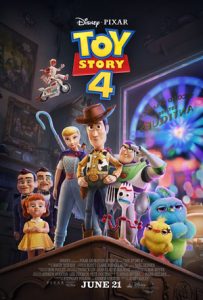 Toy Story 4 (Disney/Pixar, 6/21/19) opens with a short sequence of weather spectacle. On a rainy, stormy night, the lights are turned out in Andy’s playroom, but the toys are awake and on the alert, as one of their own has been carelessly left out in the rain. RC Car has been washed into a rain gutter from the front lawn, and is being dragged by the current toward the sewer. From the upper-story window of the room of Andy’s sister Molly, Woody and Bo Peep on Molly’s baby lamp organize a rescue mission. Three Barbies perform a precision synchronized dive onto one edge of a book balanced atop a fulcrum, launching Jessie to the upper window frame to unlock the window. Woody descends from the window sill, clinging to one end of Slinky Dog. Woody struggles to grab hold of RC’s bumper while maintaining a grip on Slinky, but the car continues to get swept downstream, and remains just out of reach. Suddenly, Woody’s reach is extended by about a foot, as the contents of the Barrel of Monkeys attach themselves between Slinky’s upper half and the windowsill to extend the lifeline. RC is caught by Woody, and the other toys haul the two up with Slinky, loop by loop. RC is hauled inside, but Woody remains clinging to the windowsill, as the adults enter Molly’s room. Bo Peep’s lamp is packed into a donation box, Molly acknowledging that she doesn’t want it anymore. Woody drops to the street below as Mom briefly leaves the box unattended at the rear of her car, racing back inside to get her keys. Woody opens the box lid, and tries to convince Bo to escape with him into the shrubbery. Bo reminds Woody that she is not Andy’s toy, and that it’s time for her to move on to the next child. With a fond look in her eyes at Woody, she makes the gentle suggestion that kids lose their toys every day, and sometimes they get packed in the wrong box, encouraging Woody to come with her. Woody is nearly convinced, and begins to reach for the box’s edge to climb in, when Andy appears at the house’s front door, searching for Woody. Reminded of his place with Andy from the writing of the boy’s name on the foot of his cowboy boot, Woody lets go of the box edge, and bids a fond farewell to Bo, as Mom returns, picking up the box and leaving Woody unnoticed in the rainy driveway as she drives away. Andy emerges from the house, happily finding his favorite cowboy doll, and returns with him inside, (Don’t worry, folks – Bo and Woody will be reunited again, years later in the story.)
Toy Story 4 (Disney/Pixar, 6/21/19) opens with a short sequence of weather spectacle. On a rainy, stormy night, the lights are turned out in Andy’s playroom, but the toys are awake and on the alert, as one of their own has been carelessly left out in the rain. RC Car has been washed into a rain gutter from the front lawn, and is being dragged by the current toward the sewer. From the upper-story window of the room of Andy’s sister Molly, Woody and Bo Peep on Molly’s baby lamp organize a rescue mission. Three Barbies perform a precision synchronized dive onto one edge of a book balanced atop a fulcrum, launching Jessie to the upper window frame to unlock the window. Woody descends from the window sill, clinging to one end of Slinky Dog. Woody struggles to grab hold of RC’s bumper while maintaining a grip on Slinky, but the car continues to get swept downstream, and remains just out of reach. Suddenly, Woody’s reach is extended by about a foot, as the contents of the Barrel of Monkeys attach themselves between Slinky’s upper half and the windowsill to extend the lifeline. RC is caught by Woody, and the other toys haul the two up with Slinky, loop by loop. RC is hauled inside, but Woody remains clinging to the windowsill, as the adults enter Molly’s room. Bo Peep’s lamp is packed into a donation box, Molly acknowledging that she doesn’t want it anymore. Woody drops to the street below as Mom briefly leaves the box unattended at the rear of her car, racing back inside to get her keys. Woody opens the box lid, and tries to convince Bo to escape with him into the shrubbery. Bo reminds Woody that she is not Andy’s toy, and that it’s time for her to move on to the next child. With a fond look in her eyes at Woody, she makes the gentle suggestion that kids lose their toys every day, and sometimes they get packed in the wrong box, encouraging Woody to come with her. Woody is nearly convinced, and begins to reach for the box’s edge to climb in, when Andy appears at the house’s front door, searching for Woody. Reminded of his place with Andy from the writing of the boy’s name on the foot of his cowboy boot, Woody lets go of the box edge, and bids a fond farewell to Bo, as Mom returns, picking up the box and leaving Woody unnoticed in the rainy driveway as she drives away. Andy emerges from the house, happily finding his favorite cowboy doll, and returns with him inside, (Don’t worry, folks – Bo and Woody will be reunited again, years later in the story.)
 A Pixar short, Partly Cloudy (5/29/09) reveals a new angle on the classic question of where babies come from. The storks are there, but as the messengers and assistants for the real creators of the children – clouds, which, with vapor-formed faces and hands, mold babies of all species out of their own vapor, passing them off for delivery by each cloud’s own personal stork. Almost all of the clouds are white, creating babies of all kinds of lovable species, such as puppies, kittens, and one who makes humans (equipping the newcomers with such items as miniature sports equipment for simultaneous delivery by its stork along with the bundle containing the blessed event). But one cloud is dark in appearance – yet no less determined in its task of churning out the next generation’s offspring. However, its tastes differ considerably from the other clouds in the appearance of its creations, as it seems to be assigned the task of producing the infants of every species which is totally lacking in cuteness. The cloud’s stork is eager to please, but painfully longsuffering, as these critters are no snap to deliver. A baby alligator nearly bites the stork’s head off, and trims his wing feathers. A baby ram repeatedly butts the stork in the face and chest. A baby porcupine fills the stork’s wings and head with quills – even through the fabric of the sack bundle. A baby shark sends such shivers of fear into the stork, that he flies off to the cloud which has been producing the human babies, appearing to desert the dark cloud. As the stork accepts a bundle from the other cloud’s hands, the dark cloud first generates a thunderstorm below it in anger, then a downpour of rain as it cries at the thought of being deserted. But a stork feather flows by the cloud’s nose, and it turns to find its stork has returned, opening the sack received from the other cloud. Inside, instead of a baby, the stork has stocked up on the sporting equipment offered by the other cloud, as he puts on a football helmet and shoulder pads for protection, just his size. Now ready, the stork beckons the dark cloud for another baby to deliver. The cloud complies with its latest creation – an electric eel. Despite taking repeated shocks, the stork and cloud embrace in renewed friendship, as the scene fades out.
A Pixar short, Partly Cloudy (5/29/09) reveals a new angle on the classic question of where babies come from. The storks are there, but as the messengers and assistants for the real creators of the children – clouds, which, with vapor-formed faces and hands, mold babies of all species out of their own vapor, passing them off for delivery by each cloud’s own personal stork. Almost all of the clouds are white, creating babies of all kinds of lovable species, such as puppies, kittens, and one who makes humans (equipping the newcomers with such items as miniature sports equipment for simultaneous delivery by its stork along with the bundle containing the blessed event). But one cloud is dark in appearance – yet no less determined in its task of churning out the next generation’s offspring. However, its tastes differ considerably from the other clouds in the appearance of its creations, as it seems to be assigned the task of producing the infants of every species which is totally lacking in cuteness. The cloud’s stork is eager to please, but painfully longsuffering, as these critters are no snap to deliver. A baby alligator nearly bites the stork’s head off, and trims his wing feathers. A baby ram repeatedly butts the stork in the face and chest. A baby porcupine fills the stork’s wings and head with quills – even through the fabric of the sack bundle. A baby shark sends such shivers of fear into the stork, that he flies off to the cloud which has been producing the human babies, appearing to desert the dark cloud. As the stork accepts a bundle from the other cloud’s hands, the dark cloud first generates a thunderstorm below it in anger, then a downpour of rain as it cries at the thought of being deserted. But a stork feather flows by the cloud’s nose, and it turns to find its stork has returned, opening the sack received from the other cloud. Inside, instead of a baby, the stork has stocked up on the sporting equipment offered by the other cloud, as he puts on a football helmet and shoulder pads for protection, just his size. Now ready, the stork beckons the dark cloud for another baby to deliver. The cloud complies with its latest creation – an electric eel. Despite taking repeated shocks, the stork and cloud embrace in renewed friendship, as the scene fades out.
 Frozen (Disney, 11/27/13) – A new twist on “The Snow Queen”, featuring two princesses instead of one. Elsa and Anna share a strong childhood love, but are very different. Elsa is the wiser, more thoughtful sister, and through unexplained means is born with a magical power to produce ice and snow from her hands, Anna is a normal girl, playful, impulsive, and gullible. As children, the two cavort in the castle of Arendale, turning large rooms of the palace into indoor winter wonderlands, building snowmen and setting up endless rows of icy slopes and slides. A misaimed shot of ice hits Anna in the head, knocking her unconscious. The king, having some unspoken knowledge regarding the nature of Elsa’s powers, take Anna for a cure to a clan of rock trolls, who materialize from boulders. They remove the ice shard within Anna’s head, but for her safety also remove all memories of Elsa’s magic powers. Elsa is informed for the first time that her powers will grow, and are of potential great danger. She is told that fear is her enemy, and she must learn to control her powers in order not to be a hazard to others. The king orders the two sisters separated, and the castle closed to visitors, until Elsa can accomplish such control. Anna, without memory of the incident, cannot understand why Elsa remains behind locked doors, and shuts Anna out of her life.
Frozen (Disney, 11/27/13) – A new twist on “The Snow Queen”, featuring two princesses instead of one. Elsa and Anna share a strong childhood love, but are very different. Elsa is the wiser, more thoughtful sister, and through unexplained means is born with a magical power to produce ice and snow from her hands, Anna is a normal girl, playful, impulsive, and gullible. As children, the two cavort in the castle of Arendale, turning large rooms of the palace into indoor winter wonderlands, building snowmen and setting up endless rows of icy slopes and slides. A misaimed shot of ice hits Anna in the head, knocking her unconscious. The king, having some unspoken knowledge regarding the nature of Elsa’s powers, take Anna for a cure to a clan of rock trolls, who materialize from boulders. They remove the ice shard within Anna’s head, but for her safety also remove all memories of Elsa’s magic powers. Elsa is informed for the first time that her powers will grow, and are of potential great danger. She is told that fear is her enemy, and she must learn to control her powers in order not to be a hazard to others. The king orders the two sisters separated, and the castle closed to visitors, until Elsa can accomplish such control. Anna, without memory of the incident, cannot understand why Elsa remains behind locked doors, and shuts Anna out of her life.
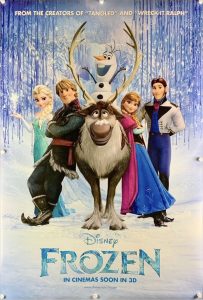 Years later, as the sisters reach young adulthood, their parents are lost in a voyage at sea. Elsa, the elder, is scheduled for a coronation. She is still wary about control of her powers, and wears a pair of thick gloves in an attempt to rehearse for accepting the royal scepter. She, however, finally comes out of hiding, and is tenuously reunited with Anna, who convinces her to open the palace gates for celebration of the coronation. Anna is exuberant in the excitement of meeting new people for the first time in ages, and quickly falls under the spell of the flirtatious Prince Hans, who, feigning love at first sight, immediately asks for her hand. Eager to believe it true, Anna asks for consent from the newly-crowned Elsa. Elsa sees right through Hans, suspecting something fishy, and refuses to accept her sister’s gullible dream, or to consent to the union. A verbal confrontation ensues between the sisters, Anna accusing Elsa of having a heart of ice, and of not caring about her, accounting for her years of shutting Anna out of her life. In the process of the confrontation, Anna pulls off one of Elsa’s gloves in attempt to keep her from leaving the hall and shutting down the celebration. Elsa gestures that she has had enough – and in the process shoots out a wall of icy spikes partially encircling her. Her power is revealed to the kingdom’s view, and Prince Hans’s emissaries declare her some sort of monster. Elsa runs in fear, as her steps begin to freeze the palace floor. She runs outside, where fear of the populace seeing her results in more clues of her powers, such as frozen fountains and icy winds. She takes off outside the palace grounds, reaching the banks of a fjord. Her steps continue to freeze all that is around her, and now extend over the waters of the fjord, providing her with the ability to walk on water, and escape her pursuers by advancing over the fjord. However, her powers remain felt by the sea water, which continues to freeze over the entire coastline, and chills the air, casting Arendale into what seems to be a never-ending winter – in the summertime.
Years later, as the sisters reach young adulthood, their parents are lost in a voyage at sea. Elsa, the elder, is scheduled for a coronation. She is still wary about control of her powers, and wears a pair of thick gloves in an attempt to rehearse for accepting the royal scepter. She, however, finally comes out of hiding, and is tenuously reunited with Anna, who convinces her to open the palace gates for celebration of the coronation. Anna is exuberant in the excitement of meeting new people for the first time in ages, and quickly falls under the spell of the flirtatious Prince Hans, who, feigning love at first sight, immediately asks for her hand. Eager to believe it true, Anna asks for consent from the newly-crowned Elsa. Elsa sees right through Hans, suspecting something fishy, and refuses to accept her sister’s gullible dream, or to consent to the union. A verbal confrontation ensues between the sisters, Anna accusing Elsa of having a heart of ice, and of not caring about her, accounting for her years of shutting Anna out of her life. In the process of the confrontation, Anna pulls off one of Elsa’s gloves in attempt to keep her from leaving the hall and shutting down the celebration. Elsa gestures that she has had enough – and in the process shoots out a wall of icy spikes partially encircling her. Her power is revealed to the kingdom’s view, and Prince Hans’s emissaries declare her some sort of monster. Elsa runs in fear, as her steps begin to freeze the palace floor. She runs outside, where fear of the populace seeing her results in more clues of her powers, such as frozen fountains and icy winds. She takes off outside the palace grounds, reaching the banks of a fjord. Her steps continue to freeze all that is around her, and now extend over the waters of the fjord, providing her with the ability to walk on water, and escape her pursuers by advancing over the fjord. However, her powers remain felt by the sea water, which continues to freeze over the entire coastline, and chills the air, casting Arendale into what seems to be a never-ending winter – in the summertime.
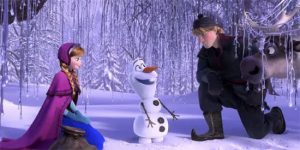 In a remote, wooded land, Elsa stops to rest, amid high peaks that her own powers have covered in snow. Deciding that she will live in hiding no more, she puts the full extent of her powers to the test, and allows her spirit to emerge so that she can be herself, in a showstopping musical number, “Let It Go”, in which she single-handedly constructs a magnificient ice palace for herself to rule in solitude. Anna, however, remains determined that she can bring about a stop to this misunderstanding and an end to the kingdom’s winter if she can only talk to Elsa. With the assistance of an ice-cutter (Kristoff) and his reindeer Sven, she attempts to track down Elsa’s whereabouts. Along the way, they encounter an unexpected friend whose existence guarantees they are on the right track – a living snowman, created by Elsa in her test of her own powers, who is a look-alike to the snowmen the sisters used to construct in their youth, named Olaf. When Olaf is told of how Elsa made summer into winter, Olaf expresses a secret desire to enjoy the warmth of a tropical summer, and to find out what solid water does in a season of heat. Anna makes Kristoff promise not to spoil Olaf’s dream, though Kristoff mutters, “Somebody’s got to tell him.”
In a remote, wooded land, Elsa stops to rest, amid high peaks that her own powers have covered in snow. Deciding that she will live in hiding no more, she puts the full extent of her powers to the test, and allows her spirit to emerge so that she can be herself, in a showstopping musical number, “Let It Go”, in which she single-handedly constructs a magnificient ice palace for herself to rule in solitude. Anna, however, remains determined that she can bring about a stop to this misunderstanding and an end to the kingdom’s winter if she can only talk to Elsa. With the assistance of an ice-cutter (Kristoff) and his reindeer Sven, she attempts to track down Elsa’s whereabouts. Along the way, they encounter an unexpected friend whose existence guarantees they are on the right track – a living snowman, created by Elsa in her test of her own powers, who is a look-alike to the snowmen the sisters used to construct in their youth, named Olaf. When Olaf is told of how Elsa made summer into winter, Olaf expresses a secret desire to enjoy the warmth of a tropical summer, and to find out what solid water does in a season of heat. Anna makes Kristoff promise not to spoil Olaf’s dream, though Kristoff mutters, “Somebody’s got to tell him.”
 Anna arrives at the ice palace with her friends, and again approaches Elsa, apologizing for her behavior at the palace, and attempting to have Elsa come back, so they can work this out together. Elsa learns for the first time that she has cast the kingdom into an eternal winter, but has no idea how to reverse it. Elsa remains fearful that she will remain a monster in the eyes of the kingdom, and tells Anna to go back to her place in Arendale, while she herself remains here in solitude. Anna persists in following, and Elsa begins putting up ice barriers in her path. Another shot of Elsa’s power us misdirected, accidentally striking Anna in the heart. Anna is thrown backwards, but struggles against it, regaining her footing. Elsa runs from what she has done, creating instead an abominable snowman as a palace guard, who pursues Anna, Kristoff, Olaf and Sven, driving them off the mountain. Kristoff observes various strands of Anna’s hair beginning to turn white, and concludes it is an effect of the icy blow received by Anna’s heart. Coincidentally, Kristoff was raised by the same clan of trolls who had cured Anna in her childhood, and Anna is taken to see them for their advice. Their elder states that ice to the heart is not as easily cured as ice to the head, and the only thing that can keep Anna from being turned to ice completely is an act of love. One such possibility is love’s first kiss – so, in hopes Anna’s naive instincts were true, the group race against time to locate Prince Hans.
Anna arrives at the ice palace with her friends, and again approaches Elsa, apologizing for her behavior at the palace, and attempting to have Elsa come back, so they can work this out together. Elsa learns for the first time that she has cast the kingdom into an eternal winter, but has no idea how to reverse it. Elsa remains fearful that she will remain a monster in the eyes of the kingdom, and tells Anna to go back to her place in Arendale, while she herself remains here in solitude. Anna persists in following, and Elsa begins putting up ice barriers in her path. Another shot of Elsa’s power us misdirected, accidentally striking Anna in the heart. Anna is thrown backwards, but struggles against it, regaining her footing. Elsa runs from what she has done, creating instead an abominable snowman as a palace guard, who pursues Anna, Kristoff, Olaf and Sven, driving them off the mountain. Kristoff observes various strands of Anna’s hair beginning to turn white, and concludes it is an effect of the icy blow received by Anna’s heart. Coincidentally, Kristoff was raised by the same clan of trolls who had cured Anna in her childhood, and Anna is taken to see them for their advice. Their elder states that ice to the heart is not as easily cured as ice to the head, and the only thing that can keep Anna from being turned to ice completely is an act of love. One such possibility is love’s first kiss – so, in hopes Anna’s naive instincts were true, the group race against time to locate Prince Hans.
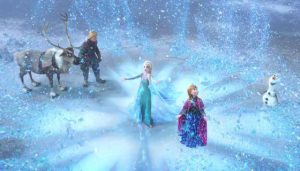 Hans, in the meanwhile, has organized a squad of soldiers to track down both Elsa and Anna (whom they presume may be in the clutches of her sister, as only her horse has returned without its rider). They too have come upon the ice palace, and face off against the snowman guard. After an eye-catching battle demonstrating an array of Elsa’s powers, Elsa is nevertheless captured, but with no sign of Princess Anna. Elsa is returned unconscious to Arendale, and manacled in a palace dungeon. Anna and Kristoff, unaware of these events, arrive, and Anna hurriedly explains to Hans her plight and need for love’s first kiss. She and Hans are left alone in a palace room, where Anna continues to shiver from the effects of Elsa’s spell, despite a brightly-burning fire in the fireplace. Prince Hans hesitantly bends to oblige Anna’s request for a kiss, but stops short, unable to follow through with it. Rethinking his position, he reveals to Anna at last that he is not really in love with her. He is the youngest of twelve brothers in his own kingdom, having no shot at royal succession unless he marries into it. He intended to marry Anna, then arrange an accident for Elsa so that he might rise to the throne of Arendale. Now knowing Anna is near death, and with Elsa also in his power, he extinguishes the fire in the room, then locks Anna in. To those outside, he announces that Anna has died at the hands of her sister, and that in her final words, Anna exchanged wedding vows with him. Hans pronounces, under his alleged new power, a death sentence upon Elsa for treason. Elsa, however, is in the process of escaping the dungeon, freezing her manacles until they crack, and placing ice barriers upon the entrance to the cell to prevent entry of the guards. Anna, too, is making an escapem having been tracked to the room by Olaf, who has picked the lock with his carrot nose.
Hans, in the meanwhile, has organized a squad of soldiers to track down both Elsa and Anna (whom they presume may be in the clutches of her sister, as only her horse has returned without its rider). They too have come upon the ice palace, and face off against the snowman guard. After an eye-catching battle demonstrating an array of Elsa’s powers, Elsa is nevertheless captured, but with no sign of Princess Anna. Elsa is returned unconscious to Arendale, and manacled in a palace dungeon. Anna and Kristoff, unaware of these events, arrive, and Anna hurriedly explains to Hans her plight and need for love’s first kiss. She and Hans are left alone in a palace room, where Anna continues to shiver from the effects of Elsa’s spell, despite a brightly-burning fire in the fireplace. Prince Hans hesitantly bends to oblige Anna’s request for a kiss, but stops short, unable to follow through with it. Rethinking his position, he reveals to Anna at last that he is not really in love with her. He is the youngest of twelve brothers in his own kingdom, having no shot at royal succession unless he marries into it. He intended to marry Anna, then arrange an accident for Elsa so that he might rise to the throne of Arendale. Now knowing Anna is near death, and with Elsa also in his power, he extinguishes the fire in the room, then locks Anna in. To those outside, he announces that Anna has died at the hands of her sister, and that in her final words, Anna exchanged wedding vows with him. Hans pronounces, under his alleged new power, a death sentence upon Elsa for treason. Elsa, however, is in the process of escaping the dungeon, freezing her manacles until they crack, and placing ice barriers upon the entrance to the cell to prevent entry of the guards. Anna, too, is making an escapem having been tracked to the room by Olaf, who has picked the lock with his carrot nose.
A final confrontation between the principal cast members takes place upon the icy fjords. Hans catches up to Elsa, getting close enough to misinform her that her sister is dead at her hands. Elsa collapses in a fit of weeping, while Hans raises a sword behind her to do her in. Anna arrives on the scene just in time to intervene, placing herself between Elsa and the path of the descending sword. Anna’s transformation to ice reaches its completion, and she freezes solid, just as the blade makes contact with her uplifted hands, shattering the weapon. Elsa witnesses her sister’s sacrifice for her, and embraces the frozen Anna, tearfully weeping and pressing her cheek against Anna’s icy-blue flesh. Olaf begins to notice color returning to Anna around her heart, which spreads across her entire body, as Anna revives and returns to life. The act of true love has been accomplished – between the sisters, and without the aid of a prince. Prince Hans and his emissaries are rounded up, and placed into the hands of his country’s prime minister, who ensures that his twelve big brothers will have something to say in decreeing a just punishment for Hans’s criminal activity. Elsa, meanwhile, realizes that the power of love is the antidote to the effects of the fear that has driven her ice powers, and with such knowledge and the love for her sister, finds the ability to thaw away the snow from Arendale, returning the kingdom to summer. Olaf loves the heat, but realizes its true effect instantly, as he begins to dissolve. Elsa arranges for him to become an all-year-round member of society, by producing over his head a cloud which travels about with him, producing his own personal snow flurry. Elsa embraces the subjects of her kingdom, declaring the gates of the palace reopened permanently, and proving that her powers can now be safely controlled and used for good, creating an ice skating rink for her subjects confined within the palace walls, while the summer continues to flourish outside, for the fade out.
Like Bambi’s April Shower, our material for this trail is drying out. As we close, the West Coast has been experiencing some record surfs and occasional passes of shower activity – proving it really does rain in Southern California. There is likely no telling what other record-or-near-record-breaking events may be on the horizon elsewhere from Mother Nature. Suffice it to say, the toons will be ready for them – and I sincerely hope all of you are too. Best wishes for peaceful, placid skies in the New Year.


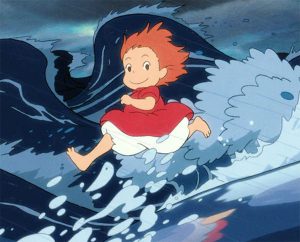
 Charles Gardner is an animation enthusiast who toils by day as a member of LA Law – but by nights and weekends indulges in classic jazz and ragtime as a performer; and studies classic Hollywood cartoons… maybe a little too much.
Charles Gardner is an animation enthusiast who toils by day as a member of LA Law – but by nights and weekends indulges in classic jazz and ragtime as a performer; and studies classic Hollywood cartoons… maybe a little too much.


































































































































































Happy New Year, Charles.
I know this is heresy, but the films of Miyazaki leave me cold.
On the other hand, I enjoyed “Cloudy with a Chance of Meatballs” a lot more than I expected to. An absurd premise taken to its logical conclusion, with plenty of laughs along the way. Flint is a worthy successor to Clyde Crashcup and Caractacus Potts.
“Let It Go” is meant to be the emotional nexus of “Frozen”, but as far as I’m concerned it sounds, and is staged, like a typically overblown entry in the Eurovision Song Contest. All that’s missing is an audience hysterically waving flags.
It’s not surprising that there’s never been an animated adaptation of “The Clouds” by Aristophanes, the Mel Brooks of Periclean Athens. Too much toilet humour and too many dirty jokes.
I look forward to starting out on the first Animation Trail of the new year and following it wherever it leads. Until then, let a smile be your umbrella on a rainy, rainy day!
Wow! My favorite animated film (The Rescuers) and my least favorite (Frozen) in one article.
Here’s a few storm sequences from animated features you have missed:
An American Tail (1987), Amblin/Univsersal, Don Bluth, dir. The Mousekowitz family are among hundreds of mice emigrating to America on a (human) ship in 1886. In the midst of the trip, the boat passes through a storm. Inside, the mice narrowly escape dangers such as hot embers and straight razors rolling on the floor. The curious young Fievel Mousekowitz sees fish coming from an open door above deck and makes his way out, despite Papa Mousekowitz’s pleads to stay. Fievel sees the upper deck of the ship as schools of fish flop by, washed on board by the storm. Losing his footing, Fievel hangs on to the rigging as massive waves — which to his young mind take the form of Poseidon himself — batter the ship. Papa holds out his hand to Fievel and manages to hold on to the sleeve, but it rips off his hand and watches helplessly as his son falls into the sea. Fortunately, Fievel manages to survive inside a bottle and washes ashore on Liberty Island, where the Statue of Liberty is still being built. From here, the film follows Fievel as he tries to reunite with his family.
Pocahontas (1995), Disney, Mike Gabriel and Eric Goldberg, dirs. A brief sequence in the beginning features a sea storm, where Captain John Smith rescues young settler Thomas after he falls overboard. It has no real purpose on the overall story, except to establish Smith as a selfless hero and give the audience something exciting before the characters reach the New World and the plot begins in earnest.
Anastasia (1997), Fox, Don Bluth, dir. The young orphan Anya, who may or may not be the Russian princess Anastasia, is on a boat trip to Paris to meet the Dowager Empress. Rasputin, here an undead wraith obsessed with getting revenge on the Romanovs, uses his dark magic to attack Anya in her dreams. The sleeping Anya finds herself on a swimming hole with the rest of her family. In reality, however, Anya is sleepwalking on the deck of the ship as a storm rages. Her father Nicolas asks her to jump into the water… as the real Anya unknowingly straddles the edge of the rail, about to plunge to her death. Fortunately, the young Dimitri, Anya’s escort, is there to save her just in time, but not before Anya sees a vision of Rasputin warning her of “the Romanov curse”.
The Iron Giant (1999) Warner Bros., Brad Bird, dir. A fishing boat off the coast of Maine is caught in a massive nor’easter, frantically radioing for help. Suddenly, something falls from the sky and lands in front of the boat. The captain is stunned silent at first, then resumes his distress call. Then he sees a light ahead, which he thinks is the lighthouse. But then the light turns, revealing a second one, and the boat crashes into something metal. The captain is shocked to find himself in front of what appears to be a giant robot towering over him. But then a wave washes him ashore, right next to the real lighthouse. He is the first to witness the titular Iron Giant, whose frantic rantings are overheard by young Hogarth Hughes, who will go on to find and befriend the metal visitor.
“Beauty and the Beast” (Disney, 1991) is worth mentioning. There’s a terrible rainstorm when Belle’s father discovers the Beast’s castle, and another during the climactic battle with Gaston. The rain is a symbol of the Beast’s loneliness and despair; the weather immediately clears up after the curse is lifted and he assumes his original human form.
Yep, and that was the first Disney movie to use what’s known as the “Dolby Digital Thunderclap” – a stock thunder sound effect that’s been used a lot since the early 1990s, named so for its’ appearance in that Dolby Digital sound system promo with the helicopter flying through the city.
Of course, what’s a Disney animated feature without a thunderstorm? “The Great Mouse Detective” was also the last one to use the old “Castle Thunder” sound effects Disney had been using since the 1940s-50s. Beginning with “Oliver & Company,” they just stuck with newer realistic thunder and lightning sound effects that had previously been introduced in “The Black Cauldron.”